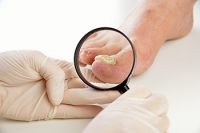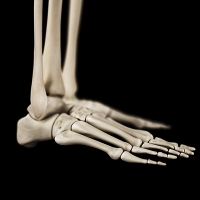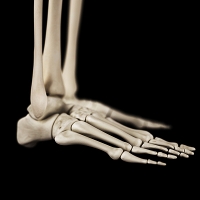
Blog (807)
Where Does Toenail Fungus Come From?
There are several symptoms that are noticeable and will determine if you are afflicted by toenail fungus. The toenail will often appear to be a yellowish color and may be thick and rough in texture. In more severe cases, the toenail may lift from the skin or break off completely. Occasionally, small black dots can be seen on the nail, which is typically considered to be dirt that has collected underneath the toenail. This type of fungus generally thrives in warm and moist surroundings and can typically be found in pool areas and saunas. It will benefit the overall health of the toenail if this condition is treated promptly. This may include undergoing a proper diagnosis, followed by medications that can be applied to the nail for mild cases. Extreme situations may call for oral medications to be ingested, despite certain side effects that may follow. If you are afflicted by this ailment, it’s suggested to consult with a podiatrist for additional information and treatment options relative to toenail fungus.
If left untreated, toenail fungus may spread to other toenails, skin, or even fingernails. If you suspect you have toenail fungus it is important to seek treatment right away. For more information about treatment, contact Dr. Kenneth Donovan of Advanced Care Foot and Ankle. Our doctor can provide the care you need to keep you pain-free and on your feet.
Symptoms
- Warped or oddly shaped nails
- Yellowish nails
- Loose/separated nail
- Buildup of bits and pieces of nail fragments under the nail
- Brittle, broken, thickened nail
Treatment
If self-care strategies and over-the-counter medications does not help your fungus, your podiatrist may give you a prescription drug instead. Even if you find relief from your toenail fungus symptoms, you may experience a repeat infection in the future.
Prevention
In order to prevent getting toenail fungus in the future, you should always make sure to wash your feet with soap and water. After washing, it is important to dry your feet thoroughly especially in between the toes. When trimming your toenails, be sure to trim straight across instead of in a rounded shape. It is crucial not to cover up discolored nails with nail polish because that will prevent your nail from being able to “breathe”.
In some cases, surgical procedure may be needed to remove the toenail fungus. Consult with your podiatrist about the best treatment options for your case of toenail fungus.
If you have any questions, please feel free to contact one of our offices located in Warren, Livingston, and Toms River, NJ. We offer the newest diagnostic and treatment technologies for all your foot care needs.
Where Does Toenail Fungus Come From?
There are several symptoms that are noticeable and will determine if you are afflicted by toenail fungus. The toenail will often appear to be a yellowish color and may be thick and rough in texture. In more severe cases, the toenail may lift from the skin or break off completely. Occasionally, small black dots can be seen on the nail, which is typically considered to be dirt that has collected underneath the toenail. This type of fungus generally thrives in warm and moist surroundings and can typically be found in pool areas and saunas. It will benefit the overall health of the toenail if this condition is treated promptly. This may include undergoing a proper diagnosis, followed by medications that can be applied to the nail for mild cases. Extreme situations may call for oral medications to be ingested, despite certain side effects that may follow. If you are afflicted by this ailment, it’s suggested to consult with a podiatrist for additional information and treatment options relative to toenail fungus.
If left untreated, toenail fungus may spread to other toenails, skin, or even fingernails. If you suspect you have toenail fungus it is important to seek treatment right away. For more information about treatment, contact Dr. Kenneth Donovan of Advanced Care Foot and Ankle. Our doctor can provide the care you need to keep you pain-free and on your feet.
Symptoms
- Warped or oddly shaped nails
- Yellowish nails
- Loose/separated nail
- Buildup of bits and pieces of nail fragments under the nail
- Brittle, broken, thickened nail
Treatment
If self-care strategies and over-the-counter medications does not help your fungus, your podiatrist may give you a prescription drug instead. Even if you find relief from your toenail fungus symptoms, you may experience a repeat infection in the future.
Prevention
In order to prevent getting toenail fungus in the future, you should always make sure to wash your feet with soap and water. After washing, it is important to dry your feet thoroughly especially in between the toes. When trimming your toenails, be sure to trim straight across instead of in a rounded shape. It is crucial not to cover up discolored nails with nail polish because that will prevent your nail from being able to “breathe”.
In some cases, surgical procedure may be needed to remove the toenail fungus. Consult with your podiatrist about the best treatment options for your case of toenail fungus.
If you have any questions, please feel free to contact one of our offices located in Warren, Livingston, and Toms River, NJ . We offer the newest diagnostic and treatment technologies for all your foot care needs.
Does Hammertoe Have to be Treated?
One uncomfortable deformity of the middle toes is hammertoe. The name is derived from the word “hammer,” as a result of the toe bending in the middle of the joint. It is typically caused by unbalanced muscles, tendons, and ligaments in the toe and will get increasingly worse if it is ignored and treatment is not sought. If certain shoes are worn, such as high heels that have a small area for the toes, the risk of developing this ailment is heightened. Other causes may include a predisposed inherited gene, certain forms of arthritis that may alter the bone structure of the foot, or injuries such as stubbing the toe. Some of the symptoms that may be experienced can be swelling and redness surrounding the affected area, open sores or corns that can form on the top of the toe, or having difficulty in keeping the toe straight. There are ways to prevent this condition from developing, such as choosing to wear shoes that have adequate toe room. If you are affected by hammertoe, see a podiatrist to learn about the best treatment options for you.
Hammertoes can be a painful condition to live with. For more information, contact Dr. Kenneth Donovan of Advanced Care Foot and Ankle. Our doctor will answer any of your foot- and ankle-related questions.
Hammertoe
Hammertoe is a foot deformity that occurs due to an imbalance in the muscles, tendons, or ligaments that normally hold the toe straight. It can be caused by the type of shoes you wear, your foot structure, trauma, and certain disease processes.
Symptoms
- Painful and/or difficult toe movement
- Swelling
- Joint stiffness
- Calluses/Corns
- Physical deformity
Risk Factors
- Age – The risk of hammertoe increases with age
- Sex – Women are more likely to have hammertoe compared to men
- Toe Length – You are more likely to develop hammertoe if your second toe is longer than your big toe
- Certain Diseases – Arthritis and diabetes may make you more likely to develop hammertoe
Treatment
If you have hammertoe, you should change into a more comfortable shoe that provides enough room for your toes. Exercises such as picking up marbles may strengthen and stretch your toe muscles. Nevertheless, it is important to seek assistance from a podiatrist in order to determine the severity of your hammertoe and see which treatment option will work best for you.
If you have any questions, please feel free to contact one of our offices located in Warren, Livingston, and Toms River, NJ. We offer the newest diagnostic and treatment technologies for all your foot care needs.
Does Hammertoe Have to be Treated?
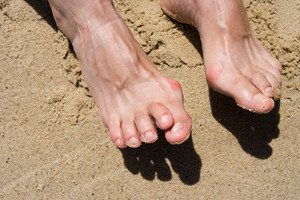 One uncomfortable deformity of the middle toes is hammertoe. The name is derived from the word “hammer,” as a result of the toe bending in the middle of the joint. It is typically caused by unbalanced muscles, tendons, and ligaments in the toe and will get increasingly worse if it is ignored and treatment is not sought. If certain shoes are worn, such as high heels that have a small area for the toes, the risk of developing this ailment is heightened. Other causes may include a predisposed inherited gene, certain forms of arthritis that may alter the bone structure of the foot, or injuries such as stubbing the toe. Some of the symptoms that may be experienced can be swelling and redness surrounding the affected area, open sores or corns that can form on the top of the toe, or having difficulty in keeping the toe straight. There are ways to prevent this condition from developing, such as choosing to wear shoes that have adequate toe room. If you are affected by hammertoe, see a podiatrist to learn about the best treatment options for you.
One uncomfortable deformity of the middle toes is hammertoe. The name is derived from the word “hammer,” as a result of the toe bending in the middle of the joint. It is typically caused by unbalanced muscles, tendons, and ligaments in the toe and will get increasingly worse if it is ignored and treatment is not sought. If certain shoes are worn, such as high heels that have a small area for the toes, the risk of developing this ailment is heightened. Other causes may include a predisposed inherited gene, certain forms of arthritis that may alter the bone structure of the foot, or injuries such as stubbing the toe. Some of the symptoms that may be experienced can be swelling and redness surrounding the affected area, open sores or corns that can form on the top of the toe, or having difficulty in keeping the toe straight. There are ways to prevent this condition from developing, such as choosing to wear shoes that have adequate toe room. If you are affected by hammertoe, see a podiatrist to learn about the best treatment options for you.
Hammertoes can be a painful condition to live with. For more information, contact Dr. Kenneth Donovan of Advanced Care Foot and Ankle. Our doctor will answer any of your foot- and ankle-related questions.
Hammertoe
Hammertoe is a foot deformity that occurs due to an imbalance in the muscles, tendons, or ligaments that normally hold the toe straight. It can be caused by the type of shoes you wear, your foot structure, trauma, and certain disease processes.
Symptoms
- Painful and/or difficult toe movement
- Swelling
- Joint stiffness
- Calluses/Corns
- Physical deformity
Risk Factors
- Age – The risk of hammertoe increases with age
- Sex – Women are more likely to have hammertoe compared to men
- Toe Length – You are more likely to develop hammertoe if your second toe is longer than your big toe
- Certain Diseases – Arthritis and diabetes may make you more likely to develop hammertoe
Treatment
If you have hammertoe, you should change into a more comfortable shoe that provides enough room for your toes. Exercises such as picking up marbles may strengthen and stretch your toe muscles. Nevertheless, it is important to seek assistance from a podiatrist in order to determine the severity of your hammertoe and see which treatment option will work best for you.
If you have any questions, please feel free to contact one of our offices located in Warren, Livingston, and Toms River, NJ . We offer the newest diagnostic and treatment technologies for all your foot care needs.
Do Your Child's Feet Hurt?
Can Being Obese Hurt My Feet?
The feet are considered to be the foundation of the body, and when the body endures pressure from being overweight, the feet bear the brunt of these abnormal stresses. Certain conditions may develop in the feet of an obese person, such as fallen arches and chronic heel pain. If children become obese, their ability to participate in sporting activities may be greatly diminished, potentially due to any pain the feet and arches may encounter. Custom-made insoles may be suggested for an overweight child to wear, and this may provide the support needed to aid in the formation of the arch. Individuals who have this condition may suffer from frequent falls, which is often as a result of a compromised gait. The feet will generally become larger and will benefit from being measured for correct sizing to avoid corns and calluses from developing. If you suffer from foot pain due to obesity, please consider a consultation with a podiatrist for dietary and lifestyle changes.
The more you weigh, the harder your feet must work to support your body. If you’re an obese individual and are concerned about your feet, contact Dr. Kenneth Donovan from Advanced Care Foot and Ankle. Our doctor can provide the care you need to keep you pain-free and on your feet.
Obesity and Your Feet
People who are overweight are putting more pressure on their ankles, knees, and hips as well as their feet. This unfortunately can lead to variety of different issues.
Problems & Complications Stemming from Obesity
- When the body is overweight, it tries to compensate by changing the way that it moves. An obese person may lean forward and put extra weight on the wrong part of the foot. This puts unnecessary stress on the feet.
- Obese people are also more likely to develop type II diabetes which is a condition that causes a lot of foot problems. People with diabetes often don’t feel the cuts and sores that they may have on their feet, which can lead to more complicated and severe issues.
- Plantar fasciitis is another foot condition that can be caused by obesity. Plantar fasciitis is an inflammation of the tissue along the bottom of the foot, which causes pain and stiffness while walking and climbing stairs.
If you have any questions, please feel free to contact one of our offices located in Warren, Livingston, and Toms River, NJ. We offer the newest diagnostic and treatment technologies for all your foot care needs.
Can Being Obese Hurt My Feet?
 The feet are considered to be the foundation of the body, and when the body endures pressure from being overweight, the feet bear the brunt of these abnormal stresses. Certain conditions may develop in the feet of an obese person, such as fallen arches and chronic heel pain. If children become obese, their ability to participate in sporting activities may be greatly diminished, potentially due to any pain the feet and arches may encounter. Custom-made insoles may be suggested for an overweight child to wear, and this may provide the support needed to aid in the formation of the arch. Individuals who have this condition may suffer from frequent falls, which is often as a result of a compromised gait. The feet will generally become larger and will benefit from being measured for correct sizing to avoid corns and calluses from developing. If you suffer from foot pain due to obesity, please consider a consultation with a podiatrist for dietary and lifestyle changes.
The feet are considered to be the foundation of the body, and when the body endures pressure from being overweight, the feet bear the brunt of these abnormal stresses. Certain conditions may develop in the feet of an obese person, such as fallen arches and chronic heel pain. If children become obese, their ability to participate in sporting activities may be greatly diminished, potentially due to any pain the feet and arches may encounter. Custom-made insoles may be suggested for an overweight child to wear, and this may provide the support needed to aid in the formation of the arch. Individuals who have this condition may suffer from frequent falls, which is often as a result of a compromised gait. The feet will generally become larger and will benefit from being measured for correct sizing to avoid corns and calluses from developing. If you suffer from foot pain due to obesity, please consider a consultation with a podiatrist for dietary and lifestyle changes.
The more you weigh, the harder your feet must work to support your body. If you’re an obese individual and are concerned about your feet, contact Dr. Kenneth Donovan from Advanced Care Foot and Ankle. Our doctor can provide the care you need to keep you pain-free and on your feet.
Obesity and Your Feet
People who are overweight are putting more pressure on their ankles, knees, and hips as well as their feet. This unfortunately can lead to variety of different issues.
Problems & Complications Stemming from Obesity
- When the body is overweight, it tries to compensate by changing the way that it moves. An obese person may lean forward and put extra weight on the wrong part of the foot. This puts unnecessary stress on the feet.
- Obese people are also more likely to develop type II diabetes which is a condition that causes a lot of foot problems. People with diabetes often don’t feel the cuts and sores that they may have on their feet, which can lead to more complicated and severe issues.
- Plantar fasciitis is another foot condition that can be caused by obesity. Plantar fasciitis is an inflammation of the tissue along the bottom of the foot, which causes pain and stiffness while walking and climbing stairs.
If you have any questions, please feel free to contact one of our offices located in Warren, Livingston, and Toms River, NJ . We offer the newest diagnostic and treatment technologies for all your foot care needs.
Symptoms of Arthritic Feet
The tendons, ligaments, and 26 bones that the foot is comprised of are responsible for standing, walking, and absorbing the weight of the body.
Painful conditions involving the feet may occur as a result of improper foot care, working on your feet, or sporting activities. If you experience pain in the feet, in addition to any swelling or tightness, you may have what is referred to as arthritis. You may notice tingling in the feet, which may indicate a circulatory condition, and the joints may begin to look deformed. It’s important to maintain proper foot care, and this may be accomplished by washing and drying the feet completely and following by applying a moisturizer. The flexibility and movement of the feet may be significantly improved by incorporating exercise into your daily routine. Please consider scheduling a consultation with a podiatrist for additional information on how to take care of arthritic feet.
Arthritis can be a difficult condition to live with. If you are seeking treatment, contact Dr. Kenneth Donovan from Advanced Care Foot and Ankle. Our doctor can provide the care you need to keep you pain-free and on your feet.
Arthritic Foot Care
Arthritis is a term that is commonly used to describe joint pain.
The condition itself can occur to anyone of any age, race, or gender, and there are over 100 types of it.
Nevertheless, arthritis is more commonly found in women compared to men, and it is also more prevalent in those who are overweight. The causes of arthritis vary depending on which type of arthritis you have. Osteoarthritis for example, is often caused by injury, while rheumatoid arthritis is caused by a misdirected immune system.
Symptoms
- Swelling
- Pain
- Stiffness
- Decreased Range of Motion
Arthritic symptoms range in severity, and they may come and go. Some symptoms stay the same for several years but could potentially get worse with time. Severe cases of arthritis can prevent its sufferers from performing daily activities and make walking difficult.
Risk Factors
- Occupation – Occupations requiring repetitive knee movements have been linked to osteoarthritis
- Obesity – Excess weight can contribute to osteoarthritis development
- Infection – Microbial agents can infect the joints and trigger arthritis
- Joint Injuries – Damage to joints may lead to osteoarthritis
- Age – Risk increases with age
- Gender –Most types are more common in women
- Genetics – Arthritis can be hereditary
If you suspect your arthritis is affecting your feet, it is crucial that you see a podiatrist immediately. Your doctor will be able to address your specific case and help you decide which treatment method is best for you.
If you have any questions, please feel free to contact one of our offices located in Warren, Livingston, and Toms River, NJ. We offer the newest diagnostic and treatment technologies for all your foot care needs.
Symptoms of Arthritic Feet
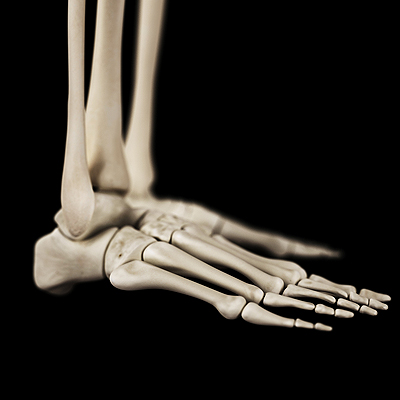 The tendons, ligaments, and 26 bones that the foot is comprised of are responsible for standing, walking, and absorbing the weight of the body. Painful conditions involving the feet may occur as a result of improper foot care, working on your feet, or sporting activities. If you experience pain in the feet, in addition to any swelling or tightness, you may have what is referred to as arthritis. You may notice tingling in the feet, which may indicate a circulatory condition, and the joints may begin to look deformed. It’s important to maintain proper foot care, and this may be accomplished by washing and drying the feet completely and following by applying a moisturizer. The flexibility and movement of the feet may be significantly improved by incorporating exercise into your daily routine. Please consider scheduling a consultation with a podiatrist for additional information on how to take care of arthritic feet.
The tendons, ligaments, and 26 bones that the foot is comprised of are responsible for standing, walking, and absorbing the weight of the body. Painful conditions involving the feet may occur as a result of improper foot care, working on your feet, or sporting activities. If you experience pain in the feet, in addition to any swelling or tightness, you may have what is referred to as arthritis. You may notice tingling in the feet, which may indicate a circulatory condition, and the joints may begin to look deformed. It’s important to maintain proper foot care, and this may be accomplished by washing and drying the feet completely and following by applying a moisturizer. The flexibility and movement of the feet may be significantly improved by incorporating exercise into your daily routine. Please consider scheduling a consultation with a podiatrist for additional information on how to take care of arthritic feet.
Arthritis can be a difficult condition to live with. If you are seeking treatment, contact Dr. Kenneth Donovan from Advanced Care Foot and Ankle. Our doctor can provide the care you need to keep you pain-free and on your feet.
Arthritic Foot Care
Arthritis is a term that is commonly used to describe joint pain. The condition itself can occur to anyone of any age, race, or gender, and there are over 100 types of it. Nevertheless, arthritis is more commonly found in women compared to men, and it is also more prevalent in those who are overweight. The causes of arthritis vary depending on which type of arthritis you have. Osteoarthritis for example, is often caused by injury, while rheumatoid arthritis is caused by a misdirected immune system.
Symptoms
- Swelling
- Pain
- Stiffness
- Decreased Range of Motion
Arthritic symptoms range in severity, and they may come and go. Some symptoms stay the same for several years but could potentially get worse with time. Severe cases of arthritis can prevent its sufferers from performing daily activities and make walking difficult.
Risk Factors
- Occupation – Occupations requiring repetitive knee movements have been linked to osteoarthritis
- Obesity – Excess weight can contribute to osteoarthritis development
- Infection – Microbial agents can infect the joints and trigger arthritis
- Joint Injuries – Damage to joints may lead to osteoarthritis
- Age – Risk increases with age
- Gender –Most types are more common in women
- Genetics – Arthritis can be hereditary
If you suspect your arthritis is affecting your feet, it is crucial that you see a podiatrist immediately. Your doctor will be able to address your specific case and help you decide which treatment method is best for you.
If you have any questions, please feel free to contact one of our offices located in Warren, Livingston, and Toms River, NJ . We offer the newest diagnostic and treatment technologies for all your foot care needs.
What causes Athlete’s Foot?
If you experience a fungus that affects your feet, you may have what is referred to as athlete’s foot. Common symptoms of this condition may include itching, blistering, or cracked skin. If you develop athlete’s foot, it’s advised to seek treatment as soon as possible so infection can be prevented. The fungus typically thrives in moist environments, and may live on shower room floors or in public pools. Athlete’s foot can easily spread, and it’s recommended that shower shoes are worn to possibly prevent this fungus from entering the skin. Additional preventive measures may include washing the feet and drying thoroughly between the toes, using a powder to absorb excessive moisture, and avoiding wearing shoes that fit incorrectly. If you have athlete’s foot, please consult with a podiatrist for additional information about prevention and treatment options.
Athlete’s foot is an inconvenient condition that can be easily reduced with the proper treatment. If you have any concerns about your feet and ankles, contact Dr. Kenneth Donovan from Advanced Care Foot and Ankle.
Our doctor will treat your foot and ankle needs.
Athlete’s Foot: The Sole Story
Athlete's foot, also known as tinea pedis, can be an extremely contagious foot infection. It is commonly contracted in public changing areas and bathrooms, dormitory style living quarters, around locker rooms and public swimming pools, or anywhere your feet often come into contact with other people.
Solutions to Combat Athlete’s Foot
- Hydrate your feet by using lotion
- Exfoliate
- Buff off nails
- Use of anti-fungal products
- Examine your feet and visit your doctor if any suspicious blisters or cuts develop
Athlete’s foot can cause many irritating symptoms such as dry and flaking skin, itching, and redness. Some more severe symptoms can include bleeding and cracked skin, intense itching and burning, and even pain when walking. In the worst cases, Athlete’s foot can cause blistering as well. Speak to your podiatrist for a better understanding of the different causes of Athlete’s foot, as well as help in determining which treatment options are best for you.
If you have any questions please feel free to contact one of our offices located in Warren, Livingston, and Toms River, NJ. We offer the newest diagnostic and treatment technologies for all your foot and ankle needs.

